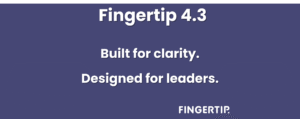Another year passed, and the calendar turned to the next one. January is a good time to pause and reflect. What should I do differently this year? Where do I want to be in another year and what do I need to do to get there?
In many ways, the influence of leaders extends to their people. As you consider your goals for this year as a leader, be sure to take these interactions into account as well. How can you best support your employees’ growth goals as well?
And what are your priorities for the organisation? To survive? Or even grow despite the difficulties? Traditionally, in abnormal times, those who dare to take calculated risks expose themselves to a level of success not available to those who slam on the brakes on investments and change.
Fingertip wants to add its perspective to this turn of the year. During 2023, we spoke about leadership to more than a thousand people in hundreds of companies. From these conversations, we can draw lessons to benefit management more generally, in keeping with current trends.
1. Humanity and human contact are the key to trust.
There is a growing talk of a mental health crisis, and it is clear that many people are experiencing loneliness and isolation at work. For younger generations, mental health is no longer taboo, and managers should not shy away from discussing it either. Emotional intelligence helps to build mutual trust, reinforces the meaningfulness of work and strengthens psychological safety. This is well worth working for. Having weekly 1-on-1 conversations between managers and their staff, for example, is an easy way to stay on top of how managers can work to remove obstacles to their people’s work.
2. Continuous improvement is part of a leader’s standard toolbox.
A rolling stone gathers no moss. A leader must never think that they are ready; it is important to listen to employees, also for self-improvement. Feedback is not criticism, but a resource to support improvement. Talking openly about one’s own shortcomings is also a way of strengthening the confidence and sense of security of the team members. This also lowers the threshold for bringing forward new ideas or identified problems, which helps the company to adapt to the changing world and enables more agile decision-making.
3. Involve people in leadership, made possible by hybrid working tools.
There is no longer justification for companies to argue that involving employees in decision making and other leadership processes is difficult and inefficient. With modern communication tools, we are all closer to each other than before, even if we see each other less often. With Fingertip, for example, anyone can set a decision making process in motion by entering a title, selecting the appropriate users from their Teams organization and opening a discussion in the channel. It’s therefore important that managers don’t turn a blind eye to the tools where their employees communicate and spend time. This growth from the ranks was behind the success of Slack. Culture is created where users are and where they interact, not in the ivory tower. That’s not to say that managers don’t have opportunities to influence culture. Building a community helps leaders care more closely about their employees and helps those employees feel a greater sense of belonging to their team.
4. Seeking resilience through efficiency.
According to usual trends during economic downturns, managers are now concerned about productivity. While new tools and management methods have long promised productivity gains, the results have been meagre. As I wrote last year, companies have not seen productivity growth for the last 15 years. Instead, the number of meetings and communication has tripled in just the last few years. So we can speculate, that the time freed up from routine tasks by greater efficiency has been wasted on more meetings. Just think what it would mean if the time spent in meetings could be harnessed for productive work? Or say half of it? How many meetings could actually be managed through channel discussion or trust-based delegation? It allows you to lead change without having to wait for the next meeting. This improves the resilience of the organization by helping to prepare for unexpected situations more quickly.
5. Don’t dismiss new technology, embrace it with open arms.
In 2024, it’s impossible to write about the future without acknowledging the huge advances in artificial intelligence. Generative AI is the elephant in the room that no one even tries to keep quiet about. That’s why every manager needs to understand, at least at a basic level, how new tools will be integrated into their daily work. As a Harvard blog says: The future of management is not dominated by AI, but enabled by it.
–
2024 may seem like a tough year, but the worst thing you can do as a leader is to fall into despair or to lock yourself in a hole and wait for better times. As leaders, we must face each day as an opportunity. An opportunity to be a better leader and a better employee, to take change by the horns, to build trust and to lead modern work with quality and efficiency. To learn to move away from old-fashioned ways of doing things and learn new ways of using AI to improve the quality and speed of day-to-day work.
Thanks for reading, I hope the article sparked some thoughts on leadership and its future. If you are interested in discussing management, I am always open to an exchange of ideas. You can reach me at [email protected], or by booking a meeting directly in my calendar. Have a great spring and good luck for the future!



